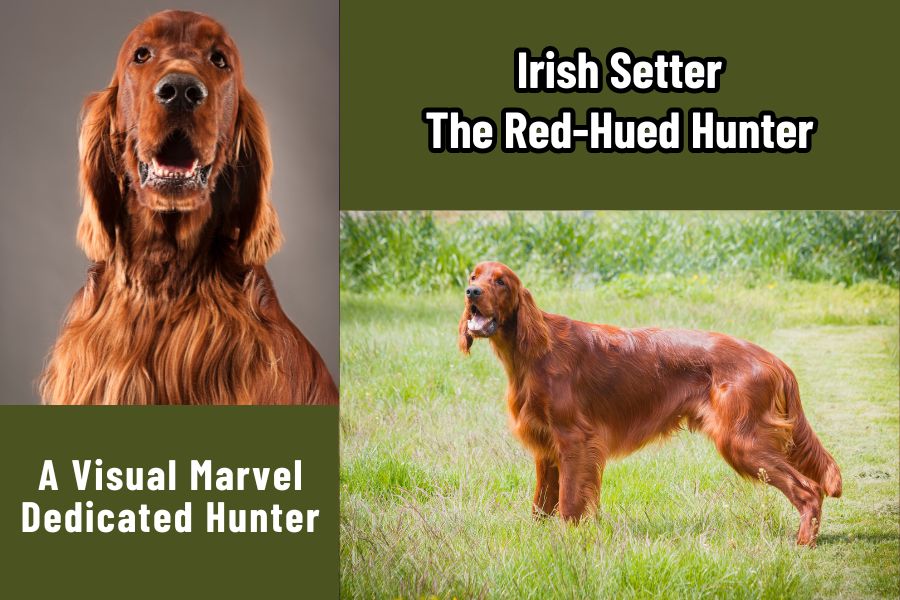The Irish Setter, discover their rich history, unique physical and behavioral traits, five key training tips and why they are excellent hunting and family dogs.
Introduction
Imagine a hunting dog so strikingly beautiful, it turns heads wherever it goes. The Irish Setter, with its flowing red coat and graceful stance, is not only a visual marvel but also a dedicated and energetic hunter. Whether sprinting through fields in pursuit of game or standing poised in a perfect point, this breed embodies the spirit of the hunt with elegance and vigor.
This guide is for those who are captivated by the charm and skill of the Irish Setter. Whether you’re a seasoned hunter looking for a new companion, a dog enthusiast wanting to understand this breed better, or a family considering an Irish Setter as a pet, this post has something for you. Let’s begin and discover the secrets of this remarkable breed.
Irish Setter Origin and History
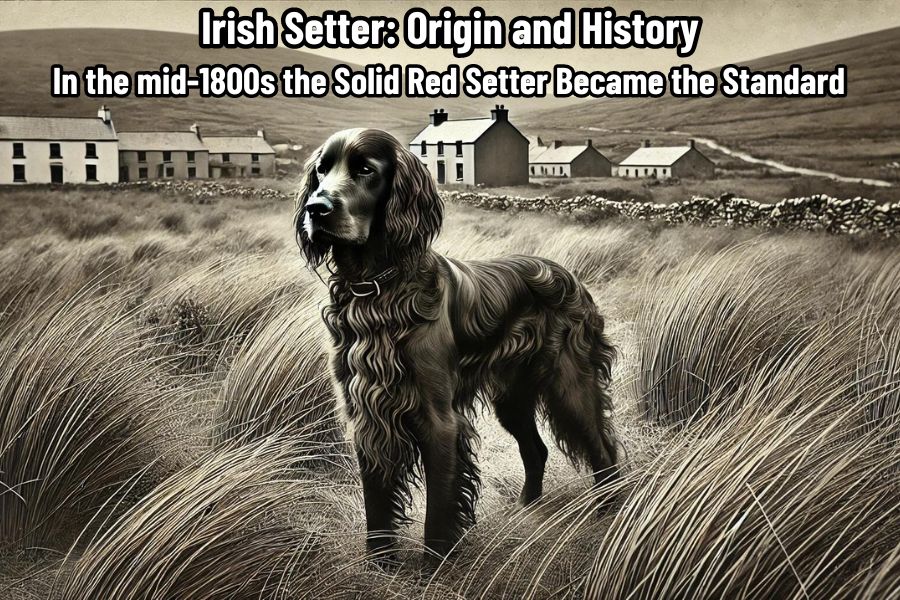
The Irish Setter’s story is as rich and colorful as its gleaming red coat. From its roots in Ireland to its status as a beloved breed worldwide, the Irish Setter’s journey is marked by purpose, evolution, and recognition.
Ancestors
The origins of the Irish Setter date back to the 18th century in Ireland. Bred for hunting, this breed is a mix of several dogs, including the Irish Water Spaniel, Irish Terrier, English Setter, and the Gordon Setter. These breeds were combined to create a dog with a keen nose, exceptional speed, and a striking appearance. Initially known for their red and white coats, it wasn’t until the mid-1800s that the solid red variety became the standard, prized for its visibility in the field.
Evolution
The evolution of the Irish Setter is marked by several important milestones. By the 19th century, the breed had gained popularity outside of Ireland, particularly in England and the United States. In 1875, the first Irish Setter was registered with the American Kennel Club (AKC), solidifying its status in the canine community. Throughout the 20th century, the breed continued to develop, with breeders focusing on enhancing its hunting abilities and aesthetic qualities. By the 1960s, the Irish Setter had become a favorite in the show ring, further establishing its reputation as both a working dog and a show dog.
Breed Status
Today, the Irish Setter is a thriving breed, both in the United States and worldwide. In the USA, it ranks among the top 80 breeds according to the AKC, with thousands of registrations each year. Globally, the breed enjoys a robust presence, particularly in countries with strong hunting traditions. The Irish Setter’s combination of beauty, athleticism, and friendly temperament continues to make it a popular choice for families and hunters alike.
Kennel Clubs
The Irish Setter’s recognition by major kennel clubs underscores its esteemed status. The American Kennel Club (AKC) recognized the breed in 1878, while the United Kennel Club (UKC) followed suit in 1922. The Kennel Club (TKC) in the UK has acknowledged the breed since its inception in 1873. Additionally, the Canadian Kennel Club (CKC) has recognized the Irish Setter since 1889. Noteworthy specialized clubs, such as the Irish Setter Club of America, established in 1891, and the Irish Setter Association of the United Kingdom, further support the breed’s prominence and preservation.
Irish Setter In Action
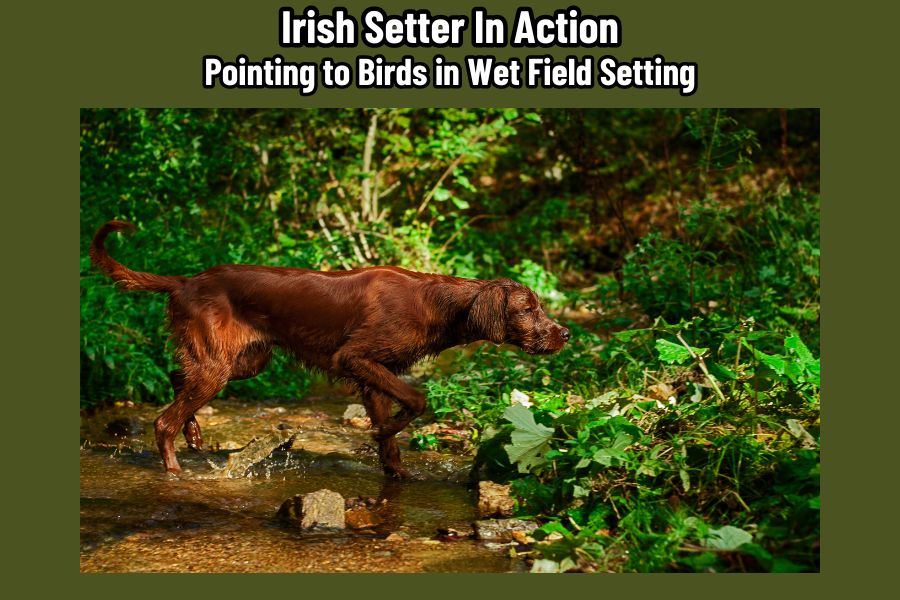
The Irish Setter is more than just a pretty face; it’s a dynamic and versatile dog with a rich history in the field. Known for its agility, keen senses, and boundless energy, the Irish Setter excels in various roles that showcase its intelligence and adaptability.
Hunting Dog
The Irish Setter hunting dog is classified as both a gun dog and a setter dog, reflecting its specialized skills in hunting. As gun dogs, they are trained to work alongside hunters that primarily use shotguns to help locate and retrieve game. As setter dogs their role involves a unique hunting technique where the dog finds game birds and adopts a pointing position, or “sets,” to indicate their presence to the hunter.
In action, an Irish Setter is trained to hunt game birds such as pheasants, quail, and grouse, as well as waterfowl like ducks. The hunting process begins with locating the game, using its acute sense of smell to track down the scent. Once the game is located, the Irish Setter will set or point, remaining still to signal the game’s location to the hunter. After the hunter flushes out and shoots the bird, the dog’s retrieving skills come into play. The Irish Setter fetches the downed game and brings it back to the hunter, demonstrating its versatility.
Other Roles
Beyond its prowess as a hunting dog, the Irish Setter also shines in various other roles. Its friendly and gentle nature makes it an excellent therapy dog, providing comfort and support in schools and hospitals. The breed’s striking appearance and graceful movement have also made it a favorite in conformation shows, where it competes for titles based on adherence to breed standards. Additionally, Irish Setters participate in field trials, showcasing their hunting abilities and competing in events that simulate real hunting scenarios. These versatile roles highlight the breed’s intelligence, trainability, and adaptability, making the Irish Setter a cherished companion in many different settings.
Irish Setter Physical Traits
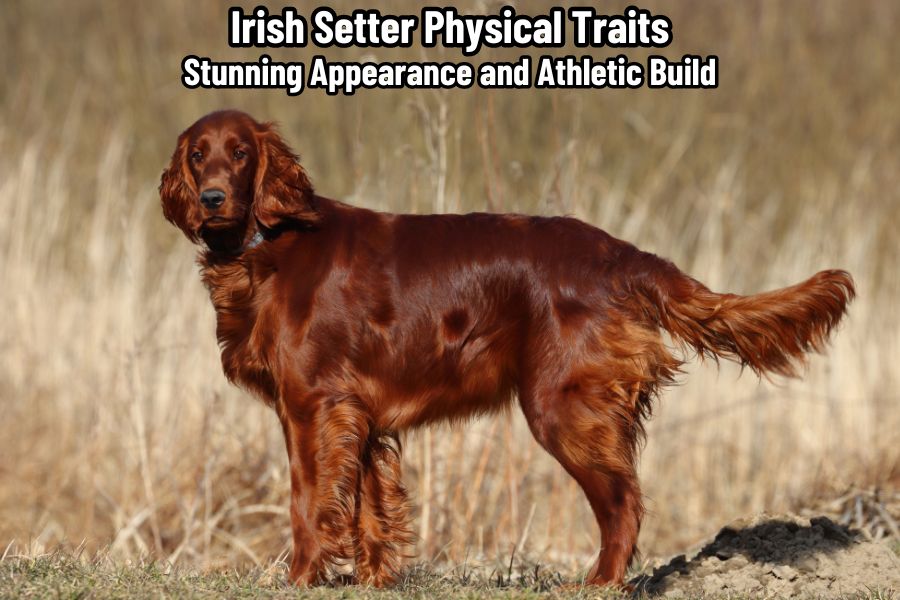
The Irish Setter is renowned for its stunning appearance and athletic build. In this section let’s examine their various physical characteristics that define this breed as an exceptional hunting dog and a beloved companion.
Strong Swimmers
Irish Setters are natural-born swimmers, a trait that makes them excellent hunters of game birds and waterfowl. Their webbed feet and strong, muscular legs allow them to glide easily through water. Beyond their hunting capabilities, Irish Setters love to play in the water with their families, making them perfect for active households that enjoy outdoor activities.
Size (Length and Height)
Irish Setters are medium to large-sized dogs, with males typically standing between 27 and 29 inches tall at the shoulder and females slightly smaller at 25 to 27 inches. Their length from chest to rear can be around 26 to 28 inches, contributing to their elegant and balanced appearance. This size makes them agile and swift, ideal for navigating various terrains during hunts.
Head and Muzzle (Soft Mouth)
The Irish Setter’s head is long, lean, and well-defined with a slightly domed skull. Their muzzle is moderately deep and ends in a black or brown nose. Known for their “soft mouth,” Irish Setters can gently carry game birds without causing any damage, an essential trait for retrieving dogs. This gentle grip also makes them excellent companions, as they can interact softly with people and other animals.
Body Structure and Weight
The Irish Setter’s body is built for endurance and speed. They have a deep chest that allows for ample lung capacity, essential for sustained physical activity. Their back is strong and slightly arched, leading to a muscular and powerful hindquarter. Males typically weigh between 65 and 75 pounds, while females range from 55 to 65 pounds. This sturdy yet sleek build enables them to cover ground quickly and efficiently.
Coat Type and Colors
One of the most striking features of the Irish Setter is its rich, mahogany-red coat. The coat is fine and straight, with longer feathering on the ears, chest, belly, and tail. This luxurious coat not only adds to their beauty but also provides some protection against the elements during hunting excursions. Regular grooming is essential to maintain the coat’s condition and prevent matting.
Keen Senses
Irish Setters possess acute senses, particularly their sense of smell, which is vital for tracking game. Their sharp vision and alert hearing also contribute to their effectiveness in the field. These keen senses make them highly responsive and attentive, both during hunts and in everyday interactions.
Tail Structure and Purpose
The tail of an Irish Setter is another distinctive feature, typically carried level with the back or slightly higher. It is moderately long, tapering to a point, and adorned with long, flowing feathering. The tail’s movement is an indicator of the dog’s excitement and focus, particularly when they are on the scent of game.
Energy and Endurance
Irish Setters are known for their high energy levels and exceptional endurance. They require ample exercise and mental stimulation to stay happy and healthy. Their boundless energy makes them excellent companions for active individuals or families who can keep up with their need for activity.
Life Expectancy
The average life expectancy of an Irish Setter is between 12 to 15 years. With proper care, including a balanced diet, regular exercise, and routine veterinary check-ups, these dogs can enjoy a long, healthy life.
Gestation Period and Litter Size
The gestation period for an Irish Setter is approximately 63 days. Litter sizes can vary, but they typically range from 6 to 9 puppies. The mother needs proper nutrition, generally at least 29 percent protein, 17 percent fat with soluble carbohydrates and a low fiber content during a pregnancy to ensure both her health and her puppies.
Irish Setter Behavioral Traits
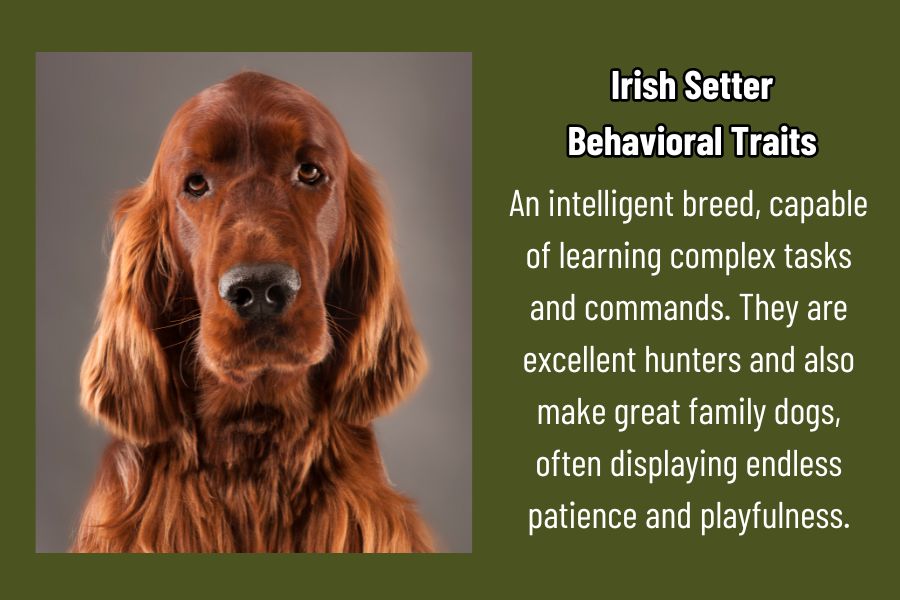
The Irish Setter is also know for its distinctive and engaging behavioral traits. Let’s explore some of these traits now:
Prey Drive
Irish Setters have a high prey drive, an inherent trait that makes them excellent hunting companions. This drive compels them to chase and locate game birds and other small animals. Their enthusiasm for the hunt is evident in their focused and energetic demeanor when tracking scents. While this trait is invaluable in the field, it also means they need plenty of mental and physical stimulation to keep them happy and well-behaved.
Intelligence
The Irish Setter is an intelligent breed, capable of learning complex commands and tasks. This intelligence makes them highly trainable and adept at problem-solving. Their ability to quickly understand and follow instructions is particularly beneficial in hunting scenarios where quick thinking and adaptability are required. However, their smart nature also means they can become bored easily, so engaging them with varied activities is essential.
Versatility
Versatility is one of the hallmarks of the Irish Setter. Beyond their versatility as hunting dogs, they excel in various other activities such as agility, obedience, and even therapy work. Their adaptability allows them to transition seamlessly between different environments and tasks, showcasing their multifaceted abilities and making them suitable for a range of roles and lifestyles.
Temperament
The temperament of an Irish Setter is generally friendly, outgoing, and affectionate. They are known for their exuberant and playful nature, often described as perpetual puppies due to their lifelong enthusiasm and energy. This cheerful disposition makes them wonderful companions who are always eager to engage with their families and participate in activities.
Trainability
Trainability is a key trait of the Irish Setter. While they are eager to please and quick learners, they can sometimes be stubborn and independent. Consistent, positive reinforcement training methods work best with this breed. Early socialization and obedience training are crucial to harness their natural instincts and channel their energy productively.
Loyalty and Protection
Irish Setters are fiercely loyal to their families and can be quite protective. While they are generally friendly with strangers, they are also alert and will bark to alert their owners of any unusual activity. This protective nature, combined with their loyalty, makes them reliable watchdogs who are devoted to keeping their loved ones safe.
Family Compatibility
The Irish Setter’s friendly and gentle nature makes them highly compatible with families. They are excellent with children, often displaying endless patience and playfulness. Their high energy levels mean they thrive in active households where they can participate in family activities. However, they do best in environments where they receive ample attention and exercise to match their lively spirit.
How to Choose the Right Irish Setter Puppy?
Choosing the right Irish Setter puppy involves careful consideration and research to ensure a happy, healthy, and well-adjusted companion. In this section we cover some important tips to help you find the perfect puppy that fits your lifestyle and expectations.
Breeder and Pedigree
When looking for an Irish Setter puppy, it’s crucial to find a reputable breeder. A responsible breeder will provide detailed information about the puppy’s lineage, health history, and breed standards. Look for breeders who are members of recognized kennel clubs, such as the AKC or CKC, and who follow ethical breeding practices. Ask to see the puppy’s parents and their health clearances for common genetic conditions like hip dysplasia and progressive retinal atrophy. A good breeder will also provide references from previous buyers along with a guarantee of the puppy’s health.
Temperament
The temperament of an Irish Setter puppy is an important factor to consider. Spend time observing the puppies in their litter to see how they interact with each other and with humans. Look for a puppy that is curious, friendly, and shows signs of being well-socialized. Avoid puppies that are overly shy or aggressive, as these traits can be challenging to manage later on. A well-balanced temperament is crucial for a harmonious relationship, especially in a family setting.
Health and Energy Level
Assessing the health and energy level of an Irish Setter puppy is essential. Ensure the puppy is active, playful, and has a shiny coat, clear eyes, and clean ears. Verify that the puppy has received its initial vaccinations and deworming treatments. Since Irish Setters are known for their high energy levels, make sure you are prepared to meet their exercise and mental stimulation needs. A healthy, energetic puppy will grow into a robust adult dog, ready for all the adventures you have in store.
Caring for Your Irish Setter
Caring for an Irish Setter involves attention to their specific needs in nutrition, healthcare, exercise, grooming, and fostering a strong bond. Let’s explore some essential tips to ensure your Irish Setter thrives in every aspect of its life.
Nutrition and Healthcare
Proper nutrition is vital for the health and well-being of your Irish Setter. Feed them a high-quality, balanced diet rich in proteins, fats, and essential vitamins and minerals. Choose a dog food that caters to their age, size, and activity level. Regular veterinary check-ups are crucial to monitor their health and catch any issues early. Keep up with vaccinations, flea and tick prevention, and dental care to ensure they remain in peak condition. Be aware of common health issues in Irish Setters, such as hip dysplasia and bloat, and work with your vet to manage or prevent these conditions.
Exercise and Grooming
Irish Setters are high-energy dogs that require plenty of exercise to stay happy and healthy. Aim for at least one to two hours of vigorous activity each day, including walks, runs, and playtime. Mental stimulation is equally important, so incorporate training sessions and puzzle toys into their routine. Grooming is another essential aspect of care. Brush their luxurious coat several times a week to prevent matting and tangles. Regular baths, nail trimming, and ear cleaning are also necessary to maintain their overall hygiene and appearance.
Building A Lasting Bond
Building a lasting bond with your Irish Setter involves time, patience, and positive interactions. Spend quality time together through activities like training, playing, and exploring new environments. Use positive reinforcement techniques to train them, rewarding good behavior with treats and praise. Consistency and patience are key, as Irish Setters can sometimes be a bit stubborn. Ensure they feel loved and secure by providing a stable and nurturing environment. Engaging with your Irish Setter in meaningful ways will strengthen your bond and create a lifelong, loyal companion.
Irish Setter 5 Key Training Tips for Hunting
Training an Irish Setter for hunting requires a clear understanding of the dog’s role and purpose in the field. Irish Setter gun dogs are specifically bred to locate, set or point, and retrieve birds without causing damage. Every aspect of their training should focus on enhancing these natural abilities. If you’re planning to train your hunting dog yourself, it’s crucial to adopt a structured approach to make your sessions more productive. Here are 5 Training Tips to help you get started:
- TRAIN RESPECT: From puppyhood through an adult dog you must establish and maintain that you are always in charge, not the dog. Always reinforce your dominance by using your natural voice, eyes, body and hand signals to manage control. Be respectful, consistent, never scream or use physical force. Fear training never works, use positive reinforcement methods.
- TRAIN COMMANDS: Train your dog to follow these commands. Start with basic commands like “sit,” “stay,” “heel,” “come,” “leave it,” and “crate or kennel” where they sleep. Follow with advanced commands like “whoa,” “back,” “over,” “find-if not using a whistle,” “fetch,” “hold,” “drop,” “crawl,” “hup,” and “down.” Master these commands first with your dog and your well on your way to having a true partner in the field and at home.
- TRAIN TO LOCATE PREY: Start training dog in a controlled setting (not a live hunt). Let dog investigate with their keen sense of smell in the controlled area. Hone their natural scent instincts by attaching a small bird wing or by adding bird scent products to a retrieve dummy and place it in different areas for the dog to find. Train dog to find dummy on and off-leash using recall commands. Get your dog used to obeying even when distracted. Praise and reward your dog each time they find the dummy. Practice until the dog understands the scent or locating process. Next start training the dog to set or point.
- TRAIN DOG TO SET: Use the scented retrieve dummy on a long string to simulate game, encouraging the setter to focus on the scent. Use a check cord to guide them and prevent chasing. When the setter locks onto the scent, gently hold them in position and use the command “whoa” to reinforce staying still. Instead of a crouch, the American standard requires Irish Setters to point standing tall. Praise and reward your dog for holding the point. Repeat frequently until dog understands how to point. Next start training dog to retrieve.
- TRAIN DOG TO RETRIEVE: Use the dummy with bird scent, move it around, and get your dog to grab it. Then, start throwing it short distances and gradually increase the distance adding the verbal command “fetch.” This is called a marked retrieve, this is when the dog sees the bird or prey fall, in other words the dog knows where it is. When the dog doesn’t see the bird fall, it’s a blind retrieve. Praise and reward your dog each time they retrieve the dummy. Repeat frequently until dog understands the retrieve process. Don’t start training on blind retrieves until your dog has mastered marked retrieves.
Don’t Get Sidetracked
Consistency is key when training an Irish Setter. It’s important to stick to your training plan and avoid introducing new techniques or commands that could confuse your dog. Each session should build on the last, reinforcing what your dog has already learned. Don’t test your dog’s abilities randomly; instead, systematically teach them the skills you want them to master. This focused approach helps your dog understand what’s expected and prevents any confusion that might arise from inconsistent training methods.
Consider Hiring a Professional Trainer
While training setter dogs can be a rewarding experience, sometimes it’s best to seek the help of a professional trainer. A professional with experience in training hunting dogs can provide invaluable insights and techniques that are specifically tailored to enhancing your dog’s hunting skills. They can offer structured training programs and hands-on guidance, ensuring your dog reaches its full potential. Investing in professional training can save time and ensure that your Irish Setter is well-prepared for the hunting field.
Conclusion
We’ve explored the origins and evolution of the Irish Setter, its impressive hunting capabilities and the various roles it can play beyond the field. Additionally we provided detailed insights into their physical and behavioral characteristics, along with practical advice on choosing and caring for an Irish Setter puppy and much more.
The Irish Setter is a remarkable breed, known for its stunning appearance, hunting prowess, and versatile nature. Embrace the journey with this amazing dog, and you’ll find a loyal, energetic, and intelligent partner for life.
FAQs: Irish Setter
What breeds make up an Irish Setter?
The Irish Setter is a blend of several breeds that were combined to enhance hunting skills and physical traits. Ancestors include the Irish Water Spaniel, Irish Terrier, English Setter, and Gordon Setter. This mix was intended to produce a dog with a keen nose, remarkable speed, and a striking red coat, making it a superior hunting companion.
Are Irish Setters hyper dogs?
Irish Setters are known for their high energy levels and playful nature. They thrive on physical activity and mental stimulation, which can make them appear hyper, especially when they don’t get enough exercise. With regular and rigorous activity, their energy can be channeled productively, highlighting their enthusiasm and spirited personality rather than hyperactivity.
How much do Irish Setters cost?
The cost of an Irish Setter can vary significantly depending on factors such as lineage, breeder reputation, and location. On average, you can expect to pay between $1,000 to $2,500 for a well-bred Irish Setter puppy. Additional costs include health screenings, vaccinations, and initial setup expenses for your new pet.
What are “marked retrieves” and “blind retrieves”?
In hunting terminology, a “marked retrieve” refers to a scenario where the dog sees the game fall and then retrieves it. This leverages the dog’s memory and marking ability. A “blind retrieve” occurs when the dog does not see the game fall and must rely on the hunter’s directions and its own scent-tracking skills to locate and retrieve the game. Both skills are crucial for a well-rounded hunting dog.
What are the potential health problems with Irish Setters?
Irish Setters are generally healthy dogs, but they are prone to certain genetic health issues. These include hip dysplasia, progressive retinal atrophy (PRA), and epilepsy. Additionally, they can be susceptible to bloat, a serious condition affecting the stomach. Regular veterinary check-ups and responsible breeding practices can help mitigate these risks.
What is the difference between Irish Setter and Irish Red and White Setter?
The primary difference between the Irish Setter and the Irish Red and White Setter is their coat color and history. The Irish Setter is known for its solid, deep red coat, while the Irish Red and White Setter has a distinct coat pattern with red patches on a white background. Historically, the Irish Red and White Setter is the older of the two breeds, with the solid red variety emerging later through selective breeding. Both breeds share similar hunting abilities and temperament but are distinguished by their appearance.
Resources: Irish Setter
SPECIAL NOTE: “The information provided in this post is based on Google research and the Resource links listed below. While we try to keep the information for this post current, there are no representations expressed or implied, about the completeness, or accuracy of the information provided. Therefore all hunters should always verify current information from these resources along with other local and federal publications”.
Online Resources
- AKC – American Kennel Club
- TKC – The Kennel Club
- UKC – United Kennel Club
- CKC – Canadian Kennel Club
- ISCA – Irish Setter Club of America
Best Books
- “The Irish Setter: A Complete and Reliable Handbook” by Janice Biniok
- “Irish Setters” A detailed guide into the breed’s history by Nona Kilgore Bauer
- “Irish Setter (Comprehensive Owner’s Guide)” by Robert G. Smith
- “The New Complete Irish Setter” by Deborah Wood

